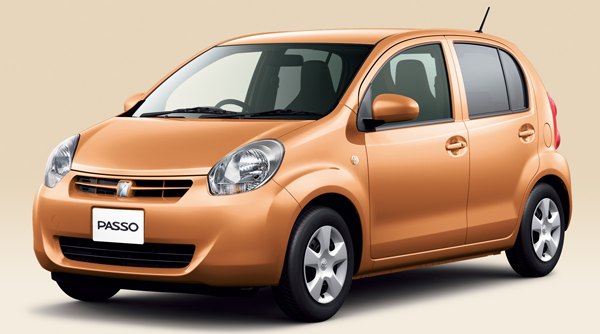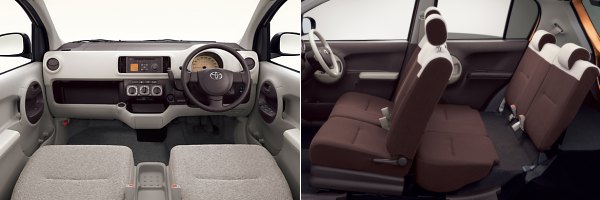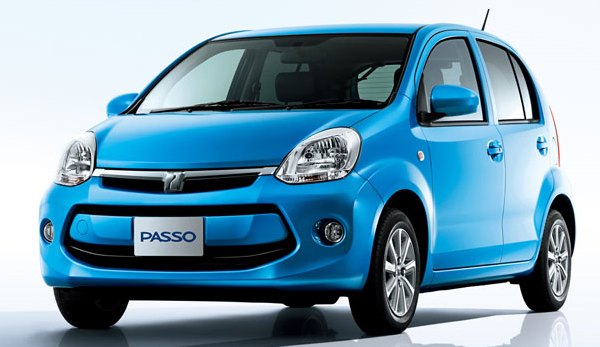|
|
|
Published
on 28
Apr 2014
|
All rights reserved.
|
|

|
10 years ago, Toyota
and its subsidiary Daihatsu jointly developed a small city hatchback.
It was called Toyota Passo or Daihatsu Boon. Strongly oriented to young
women drivers for town use, the duo was quite popular in Japanese
cities. In the form of Perodua Myvi it has also been the best selling
car in Malaysia for many years. Measuring 3.65 meters in length, 1.67
meter in width and 2440 mm in wheelbase, the car was a little larger
than a typical K-car. The same went for its 1.0 and 1.3-liter engines.
It therefore offered more space and performance than the compromised
K-cars yet remained much cheaper to buy and run than a conventional
Corolla.
Somehow, Toyota did not try to expand its sales globally. There might
be better options for the task, such as Vitz/Yaris and Vios, therefore
the second generation launched in 2010 was not an ambitious redesign.
Not only its concept remained loyal to the original, its basic platform
was carried over from the old car. You can see the body dimensions are
virtually unchanged, as are the general proportion and the range of
engines. This is something unusual for a Japanese car having spent 6
years on the market. Put it this way, Toyota did not want to spend too
much money on a car with limited market potential.

|
What the second generation brings is a new packaging. Having installed
some female designers in its development team and listened to the
voices of female buyers – who should account for 70 percent of its
sales, Toyota made the exterior rounder and cuter, and the interior a
warmer, more inviting place. The redesigned dashboard finally has some
style to speak of, and it is made of grained (if hard) plastics which
can be ordered in various colors. Ditto the door panels and seat
fabric. Front bench seats contribute further to a relaxing feel.
Meanwhile, visibility is improved by raising the driver seat by 10 mm
and lowering the belt line by 10 mm.
As before, the cabin of Passo is highly functional – there are
countless of large and small storage cubbies to store your oddities,
and the seats can be split and fold to form a flat luggage bay. The
doors open to nearly 90 degrees for easy entry. Passenger space is
surprisingly generous for such a small car, as the rear bench truly
fits for two average-size adults.

|
As the car is designed primarily as a city car, most buyers would find
the 1.0-liter 3-cylinder VVT-i engine adequate. The Daihatsu-built
engine is carried over from the Mk1 thus it produces an unchanged 69
horsepower. To drivers often take their cars to highway, thrashing the
small motor crazily for extended period could be painful. This mean the
1.33-liter 4-cylinder VVT-i would be a better option. Shared with
Toyota iQ and Vitz, this new motor produces 5 more horsepower than
before and offers slightly better low-end torque. Both engines are
paired with a new CVT instead of 4-speed auto in order to enhance fuel
economy. More sound deadening materials are employed to offset the
excessive engine noise associated with rubberband effect.
Unsurprisingly, the domestic-bounded Passo is not designed to excel on
twisty roads. Its chief merit is an easy driving manner, thanks to
short turning radius and light steering. The soft suspension setup
results in lots of body roll through fast corners, and the handling
favours safe understeer. The electrical power steering feels lifeless
in Toyota fashion. There is little fun to speak of.

|
2014 facelift
This year, the Passo is receiving a mild facelift. Its new face shows
strong influence from Volkswagen Up. The interior is generally
untouched except some equipment updates. Under the bonnet, a brand new
1.0-liter three-pot arrives. Despite of unchanged output numbers, it
cuts fuel consumption by 17 percent (according to Japanese combined
cycle) thanks to Atkinson combustion cycle, automatic stop-stop and
regenerative starter/alternator. Normally, Atkinson cycle would
compromise power, but this engine compensates with an unusually high,
11.5:1 compression ratio, which is made possible by using cooled
exhaust gas recirculation and a high-tumble port design, both serve to
reduce the likelihood of knock. Sadly, while rivals succeed in
achieving improved fuel economy and power simultaneously, Toyota
ignores the call for more performance. For keener drivers with a
limited budget, Suzuki Swift would be a much better option.
|
Verdict:   |
|
|
|
|
|
|
|
|
|
|
Passo
1.0
|
2010
|
| Front-engined,
FWD |
| Steel monocoque |
| Mainly steel |
| 3640 / 1665 / 1535 mm |
| 2440 mm |
Inline-3
|
| 996 cc |
DOHC 12 valves, VVT
|
| - |
| - |
69 hp
|
68 lbft
|
CVT
|
F: strut
R: torsion-beam
|
-
|
| 165/70R14 |
910 kg
|
-
|
-
|
-
|
|
Passo
1.3
|
2010
|
| Front-engined,
FWD |
| Steel monocoque |
| Mainly steel |
| 3640 / 1665 / 1535 mm |
| 2440 mm |
Inline-4
|
| 1329 cc |
DOHC 16 valves, VVT
|
| - |
| - |
95 hp
|
89 lbft
|
CVT
|
F: strut
R: torsion-beam
|
-
|
| 165/70R14 |
940 kg
|
-
|
-
|
-
|
|
Passo
1.0
|
2014
|
| Front-engined,
FWD |
| Steel monocoque |
| Mainly steel |
| 3650 / 1665 / 1535 mm |
| 2440 mm |
Inline-3, Atkinson-cycle
|
| 996 cc |
DOHC 12 valves, VVT
|
| - |
| - |
69 hp
|
68 lbft
|
CVT
|
F: strut
R: torsion-beam
|
-
|
| 165/70R14 |
910 kg
|
-
|
-
|
-
|
|
|
|
|
|
Performance
tested by: -
|
|
|
|
|
|
|
|
|
Copyright©
1997-2014
by Mark Wan @ AutoZine
|
|